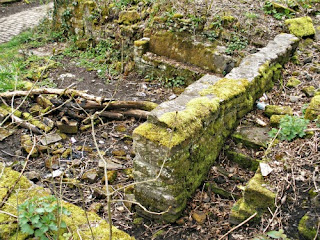Our little ramble starts at St James' Church on Chapel Lane (SJ8506 1390). The chapel dates from the early 1500s, being built by the Holt family of Ashworth Hall for their tenents. Go past the pub (Egerton Arms, now a private house) and turn left onto Ashworth Road and then left again onto School Lane to look at Ridd Cottages and the old school/parish hall. The tiny school-house was built by Wilbraham Egerton in 1838 for the Ashworth Estate. It closed in 1900. Today it is St James' parish hall. Carry on along School Lane to Carr Woods. At the bridge over the Naden Brook notice a gated driveway on the right-hand side. Here was the entrance to the former Carr Woods tea rooms (now a private residence). Now go back up the lane a bit and take the footpath on the right- hand side (between the two gates) and walk along here through the woods beside the steep-sided, precarious bank along which the Naden brook flows. Follow this path, which is a former tramway, for half a mile until you reach a modern curved wooden bridge. Here Mill Croft brook joins the Naden brook at Wolstenholme Fold, near Norden.
Here at Coal Bank in Fester Clough (Ordnance Survey Grid Reference: SD 85592 14167) we have now reached the objective of our ramble the site of a cotton-spinning mill beside the Naden brook. Although the cotton spinning mill-cum-bleach-works has been almost obliterated - if you look closely you can still find the ruins of this one-time industrial enclave. In the 19th century the place began life as a cotton spinning mill, but in the late 19th century the mill became a bleach works. Then in the early part of the 20th century the works closed down for good after a fire consumed the building in 1916. Much of the mill building was then pulled down and great quantities of the stonework taken away to local places. Part of a wall still stands as do the foundations of buildings, including the lodge? The Coal Bank mill chimney has recently been pulled down and the site levelled somewhat in order to make way for new pathways and modern wooden bridges - and to make a nice place to stroll and enjoy one's self in this peaceful place.
Now follow the path across the little bridge and turn to the left in the direction of the Black Pits Chimney and the Norden bus terminus. The very tall chimney is, now very sadly, all that remains of the Black Pits cotton-spinning mill that had flourished during the 19th and the early 20th century. A new modern housing estate now fills this once thriving industrial valley along which flows the Naden brook. Notice also a spring of water flowing into a water trough at the side of the footpath; this would have been used by thirsty horses pulling carts along the cobbled trackway. We now reach the end of our ramble.
Copyright © RayS57, 2012 (Updated 2023).


























